Trevor Hughes
Prof. Wagenius
8 December 2017
Field Site Burning Effects on Liatris and Solidago Species: Year 2
Background Info:
Habitat fragmentation threatens the livelihood of many remnant prairie populations in the midwestern United States. This is the result of various biological mechanisms such as limited genetic diversity and transformation of the surrounding ecosystem, both of which yield direct effects on the plant species coexisting there (Newman and Pilson 1997, Saccheri et al. 1998). Through either modification potential mates location as well as other changes in pollinator behavior, the reproduction of these species is left especially vulnerable to change (Wagenius 2006). These reproduction patterns are measured in what is commonly referred to as seedset, or the percentage of fertile achenes (those that possess an embryo) out of a certain grouping of total achenes; therefore, seedset effectively displays the relative amount of achenes that are fertile on any given inflorescence.
Previous research reveals that both pollinator activity and respective reproduction of native plant species decrease with habitat fragmentation; as well, many of these studies focused on select species, namely the Echinacea angustifolia, a common plant species often found in midwestern prairie remnant habitats (Wagenius 2006). Differing from prior research, this study focuses on how a contemporary trend—the burning of a specific remnant prairie habitat—could be affecting the reproductive activity of remnant prairie plant species. Expanding beyond Echinacea, this study focuses on two other key prairie species: Liatris and Solidago. By examining two different sides (east and west) of a specific remnant prairie site where the east and west sides are burned interchangeably on a repeating pattern: east side burned, west side burned, and no side is burned. This report analyzes the findings concerning the second year of the study, where no field site was burned. While the specific findings discussed will be limited to this year’s data, with next years data, the study hopes to aggregate all years to yield some conclusions as to the effects of field site burning on reproduction of prairie plant species. Aside from investigating the possible effect that field-site burning has on the seedset of the plant species in the area, it also hopes to be able to provide comparable findings between Liatris, Solidago, and Echinacea so that findings regarding habitat fragmentation can be generalized to more prairie plant species in the future.
Methods:
Liatris and Solidago were gathered at the Staffanson site within the Douglas county in western Minnesota (centered near 45°49’ N, 95°43’ W). They were collected using a randomized method, with 90 Liatris and 74 Solidago inflorescences collected in total. However, the Liatris and Solidago species were collected from both the East and West sides of the Staffanson site, but a blind-procedure was used to ensure this was not known during the data collection or analysis process. It should be noted that while the West field site was burned last year, no field site was burned this year in preparation for burning the East field site and continuing the cycle in 2018.
Following the collection process, the Liatris and Solidago inflorescences were randomized using excel software and put in their appropriate order, divided by species. This prevents bias at multiple steps during the course of data collection, including cleaning, counting, and x-raying. Beginning with Liatris, a bag was selected according to the random order and all heads were removed from the inflorescence to be cleaned. Next, thirty achenes were selected randomly using a grid system under the container to be used as an x-ray sample for that inflorescence. The remaining achenes were separated from any chaff and placed in an envelope for future reference and potential research. This process was repeated with all 90 Liatris samples. Additionally, beginning with the 50th randomized Liatris sample and continuing until all remaining Liatris samples were cleaned, the number of achenes in the top, middle, and bottom head were also recorded in a spreadsheet. If there was no clear middle, the achene closest to the bottom relative to the midpoint was chosen.
The Solidago process was quite similar. The bags were selected in a pre-randomized order and the inflorescence was removed to be cleaned. However, due to the considerable number of achenes on most Solidago inflorescence, it would be impractical to attempt to use all achenes for cleaning; therefore, I simply shook each inflorescence for 10 seconds and used those achenes for further analysis. From there, 30 achenes were randomly placed into a small plastic baggie for x-raying whilst other achenes were separated and placed into an envelope for further comparison. This process was repeated for all 74 solidago samples.
After the cleaning was completed, the baggies were placed on sheets to prepare for x-raying. Twenty samples were x-rayed at a time and there scans were recorded. Lastly, the x-ray samples were counted for the number the number of achenes in each sample that actually contained a fertile embryo; in this way, the seed-set of the Liatris and Solidago achenes was recorded so that comparisons between the east and west Staffanson field sites could be made.
Results:
All data was aggregated and analyzed with use of various statistical tests on the R platform; all figures and/or tables were also made on this same platform. Data regarding the top/middle/bottom breakdown of Liatris along with the seedset of Liatris and Solidago on the east and west sides of the Staffanson site were analyzed for potential findings.
Figure 1: Location of Head vs. Size of Head in Tops/Middles/Bottoms of Liatris

The tops of the Liatris species were found to have the greatest number of achenes with a mean number of achenes of 24.367, middles followed with a mean of 21.667, and bottoms yielded the lowest mean at 20.867 (see Figure 1). A bootstrap test was conducted between the means of the tops and middles, generating a p-value of 0.019, meaning that there is only a 1.9% chance that the difference in size of head betweenst tops and middles would be found by chance simply by sampling randomly from inflorescences (see Figure 2). While a p-value was not calculated for the difference in size of head amongst tops and bottoms, it is speculated that this analysis would yield a even lower p-value than tops and middles due to the greater difference in mean. While a bootstrap test was run between middles and bottoms, this yielded a high p-value and indicated there was a large possibility that the difference between middles and bottoms of Liaris could be found by chance from sampling randomly and was therefore not determined to be an meaningful finding.
Figure 2: Bootstrap Test for variance between Tops and Middles of Liatris
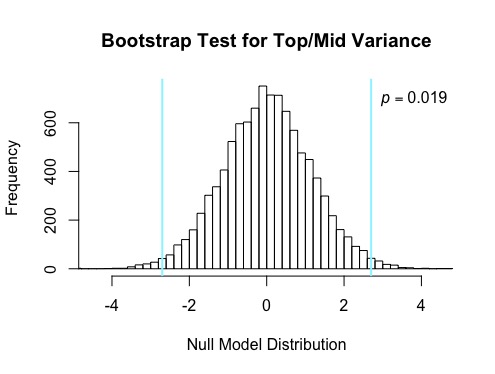
The data collected on seedset for the 90 Liatris samples was aggregated and eventually divided between East and West lines of the Staffanson site. The mean seedset was calculated for each side and are compared below (see Figure 3). The East meen seedset of Liatris was 35.2%, which towers over the West’s 20.6%.
Figure 3: Side of Staffanson Site vs. Mean Seedset of Liatris

A bootstrap test was run on this dichotomy to determine the confidence intervals of these findings as well as the p-value. The ablines were found to fall outside of the normal distribution, yielding a p-value of 0.1%, indicating that this difference has a very little possibility of resulting from chance and that the difference in seedset between the East and West is quite noteworthy and telling of other possible differences between these two sites. The confidence intervals were not found to overlap, strengthening the certainty of my findings (see Figure 4).
Figure 4: East and West Sides of Staffanson vs. Mean Seedset of Liatris with 95% C.I.

Identical tests were conducted on the 74 Solidago samples and respective seedset data, but different findings were discovered. The seed-set data collected for Solidago was divided between the east and west sides of the Staffanson site. The mean seed-sets of each side were calculated, revealing to be 35.9% for the east and 32.7% for the west (see Figure 5). This demonstrates that the east had a higher seed-set, but not at the same large interval seen with the Liatris species. Confidence intervals and a p-value were also determined for each side. The p-value was revealed to be 36.45%, which indicates the potential for this difference in seed-set to result a large portion of the time from natural variation, and not possibly due to the difference in side of the Staffanson site (see Figure 6). Supporting this large p-value, the confidence intervals also overlap, indicating that the variables could potentially swap and vary greatly in repeating this study, generating further doubt on the implications of this finding.
Figure 5: Side of Staffanson Site vs. Mean Seedset of Solidago
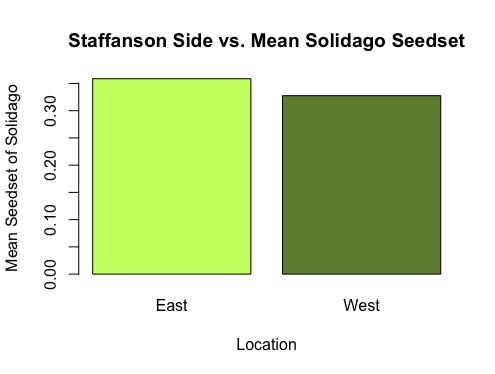
Figure 6: East and West Sides of Staffanson vs. Mean Seedset of Solidago with 95% C.I.
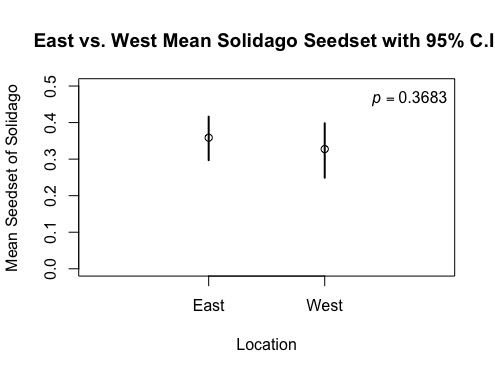
Discussion:
Firstly, the data regarding the tops/middles/bottoms of Liatris demonstrate a definite correlation among location and size of head. Based on the low p-value, it can be determined that the tops have the greatest number of achenes, compared to the middles and bottoms, but whether or not there is a significant difference in the number of achenes betweenst middles and bottoms cannot be directly determined from this data set. While this data indicates a trend between location and size of head (with greatest numbers of achenes found among the top heads), more samples should be collected and analyzed to strengthen this finding, specifically with regards to the difference in size between middles and bottoms.
Before the data from this years seedset among the east and west sides of the Staffanson site can be analyzed, the findings from last year’s study (when the West side was burned), must be discussed. The 2016 data indicates that the West had a higher mean seedset than the East for Liatris, but there was little to no correlation between the east and west with Solidago. This finding is interesting for a couple of reasons. For one, this directly contrasts with my data from this year (where no sides were burned), as now the east had nearly a 75% increase in seedset compared to the West. Interestingly, the east side now has the larger seedset, meaning the sides of the field swapped by a large margin. This also contrasts with what one would expect with a field burning, which generally is speculated to stimulate growth, achene development, and seedset. However, it appears from this data set that the burning possibly hinders achene development and seedset, but this cannot be completely determined from this data set. The data from 2018 (when the East side is burned), would be vital for drawing this conclusion.
Interestingly enough, while the data sets contradict themselves on these grounds, they agree on one important point: field site burnings have a greater impact on Liatris than Solidago. This raises questions as to what biological mechanism within each species accounts for this difference. Once again, data from 2018 would also be vital for making a definitive conclusion as to why field site burning seems to have a lessened impact on the Solidago species.


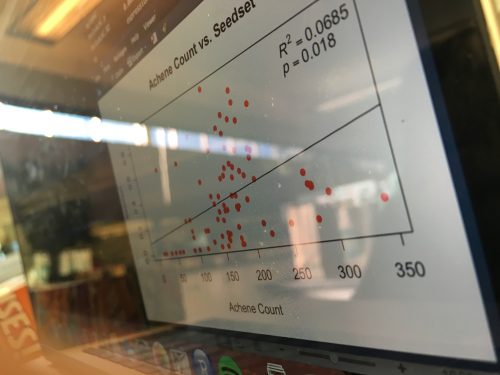 Nina calculated the percent of invasive species for each of her plots using data from the United States Department of Agriculture (USDA) website. She used these percentages to create various graphs to attempt to predict the success of echinacea based on the number of invasive species. However, she found that this was not an effective way of predicting echinacea success. Aside from these quantitative activities, Nina also worked on “beautifying” her graphs, which includes adding R-squared and p values. Look at the red graph to the left, isn’t it beautiful?!
Nina calculated the percent of invasive species for each of her plots using data from the United States Department of Agriculture (USDA) website. She used these percentages to create various graphs to attempt to predict the success of echinacea based on the number of invasive species. However, she found that this was not an effective way of predicting echinacea success. Aside from these quantitative activities, Nina also worked on “beautifying” her graphs, which includes adding R-squared and p values. Look at the red graph to the left, isn’t it beautiful?!


 On the other hand, Nina moved on to randomizing today to prepare her samples for x-raying, which she admits was a more tedious task than she had initially anticipated. But she is very enamored with her randomization wheel that she has so much that it makes up for the meticulous task it is (see exhibit A to the left). She finished about half of her bags and reports feeling “hatisfied” with her progress. She hopes to be done by tomorrow so she can prepare het sheets for x-raying for Wednesday. She also reports that she is looking forward to counting because it is a beautiful, non thought-provoking task.
On the other hand, Nina moved on to randomizing today to prepare her samples for x-raying, which she admits was a more tedious task than she had initially anticipated. But she is very enamored with her randomization wheel that she has so much that it makes up for the meticulous task it is (see exhibit A to the left). She finished about half of her bags and reports feeling “hatisfied” with her progress. She hopes to be done by tomorrow so she can prepare het sheets for x-raying for Wednesday. She also reports that she is looking forward to counting because it is a beautiful, non thought-provoking task.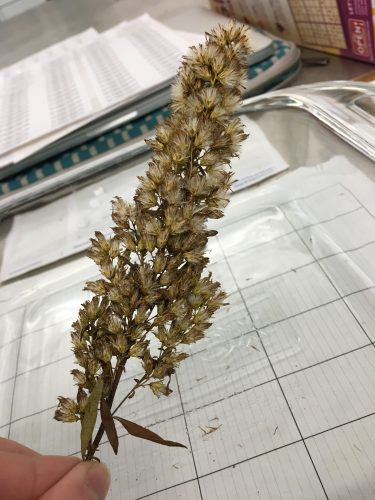
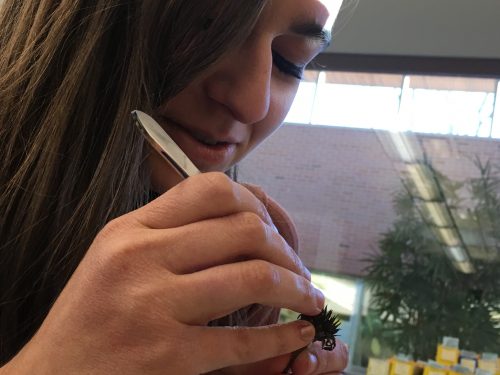 Nina began meticulously rechecking her achenes. As you can see above, she was very focused. She actually invented a fun game where she would tally how many buds were missed by various people that assisted her in cleaning. As is stands now, Lea is in lead with 2 missed, Tracie second with 3 missed, and Nina (who did 60 of them mind you) is third with 4 missed. Max. On some, she even missed none! Marisol is in fourth with 5 missed, but who knows? She’s still counting! Updates to follow.
Nina began meticulously rechecking her achenes. As you can see above, she was very focused. She actually invented a fun game where she would tally how many buds were missed by various people that assisted her in cleaning. As is stands now, Lea is in lead with 2 missed, Tracie second with 3 missed, and Nina (who did 60 of them mind you) is third with 4 missed. Max. On some, she even missed none! Marisol is in fourth with 5 missed, but who knows? She’s still counting! Updates to follow.
 My buds are much less stubborn and the achenes easily fall off. In fact, my buds actually look quite different from the echinacea achenes, resembling a miniature version of the capitulum often emitted from dandelions, making them quite fun to work with! Pictured to the right, these are the achenes I separated into baggies for future x-raying (notice the formation!)
My buds are much less stubborn and the achenes easily fall off. In fact, my buds actually look quite different from the echinacea achenes, resembling a miniature version of the capitulum often emitted from dandelions, making them quite fun to work with! Pictured to the right, these are the achenes I separated into baggies for future x-raying (notice the formation!) Hello! My name is Trevor Hughes and I am a freshman at Carleton College in Northfield, MN. I am super fortunate to be joining Project Echinacea for an internship over my winter break; I’m super excited about it! Prior to my time at Carleton, I spent most of my time in high school working on the Conservation Ambassadors Board at Lincoln Park Zoo, planning events related to conservation. Fun fact: one of my events concerned urban prairie plant species (including echinacea!); how cool is that?! And through my time there, I grew to develop a passion for conservation, which will continue to grow in fortitude during my time at the Chicago Botanical Garden. Over the course of my internship, I will be working on cleaning, scanning, and counting achenes from the Liatris and Solidago species, hoping to discover findings comparable to echinacea, proving that conclusions made with regards to echinacea can be generalized to other prairie plant species in the future.
Hello! My name is Trevor Hughes and I am a freshman at Carleton College in Northfield, MN. I am super fortunate to be joining Project Echinacea for an internship over my winter break; I’m super excited about it! Prior to my time at Carleton, I spent most of my time in high school working on the Conservation Ambassadors Board at Lincoln Park Zoo, planning events related to conservation. Fun fact: one of my events concerned urban prairie plant species (including echinacea!); how cool is that?! And through my time there, I grew to develop a passion for conservation, which will continue to grow in fortitude during my time at the Chicago Botanical Garden. Over the course of my internship, I will be working on cleaning, scanning, and counting achenes from the Liatris and Solidago species, hoping to discover findings comparable to echinacea, proving that conclusions made with regards to echinacea can be generalized to other prairie plant species in the future.